| However, they are not
alone and actually being watched by a
pair of hateful eyes from out of the
shadows. As Selina breaks away quite
suddenly and bids Bruce goodnight
abruptly, Gotham's fashionable
millionaire wonders what caused this
rupture - was it Selina's memories of her
life as Catwoman or was it something she
sensed in him and his alter ego? Back
at Selina's apartment we learn that she
herself thought that Bruce changed
completely upon the mere mentioning of
the word "Catwoman", but she
has no time to further pursue those
thoughts as an intruder breaks into her
dewllings - and it is no one else than
Cat-Man, whom Selina thought dead.
However, just like his feline
role-models, Cat-Man himself seems to
have nine lives. He immediately attacks
Selina, and in the ensuing struggle she
catches a glimpse of Cat-Man's face and
notices with horror that one half is
terribly disfigured...
The scene switches to
Gotham General Hospital, where Batman
pays a visit to Dr Thirteen, the
"Ghost Breaker", who had helped
him and Commissioner Gordon link what
appeared to be a ghost haunting Wayne
Manor to Man-Bat (as told in Batman
#341-342).
Dr Thirteen is now
suffering from partial amnesia after a
fall, which is a stroke of luck for
Batman as the Ghost Breaker had
discovered the secret entrance to the
Batcave and thus Bruce Wayne's secret
identity in the course of that
investigation.
|
|
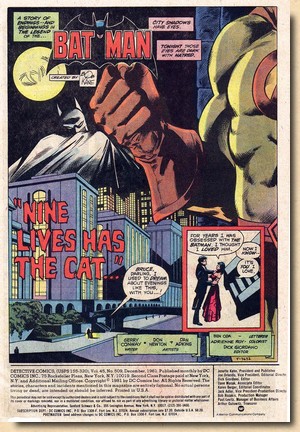 |
|
|
| |
| As both
Commissioner Gordon and Batman seem rather unnerved about
the upcoming mayoral election - with both candidates
having law and order issues as the main point on their
political agenda - the Darknight Detective investigates
an alarm at the Wayne Research Institute facilities,
located at the tip of Long Island. Because biological
research is an important part of the Institute's
research, Batman first suspects that Poison Ivy might be
involved, but the fact that the locks have been forced
open and the alarm system sabotaged points to a different
modus operandi. Batman checks on the piece of
the Cat-Man's cape which is kept at the facilities in
order to reserach its apparent healing effects - an
effect the cape has obviously also had on Cat-Man himself
who hurls himself at Batman from out of the shadows... |
| |
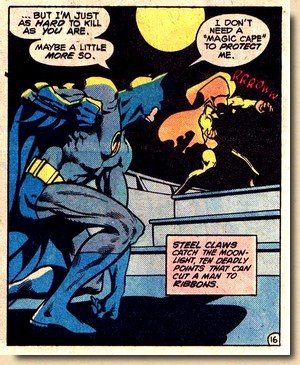 |
|
Cat-Man was once a
jungle game hunter named Tom Blake, and
like a cat he is quick and cunning - as
Batman once again is forced to
acknowledge as the fight between the two
masked men shifts into top gear and he is
caught off guard in a brief moment of not
keeping up his defenses. As
Batman regains consciousness, he finds
himself tied firmly to poles rammed into
the ground of the beach and a triumphant
Cat-Man telling him that he will drown as
the tide is now coming in... and that is
all Cat-Man wants: to see Batman dead, in
revenge for their last encounter (which
also saw Catwoman partaking in the fight)
and which sent Cat-Man falling into a
geysir. Only thanks to his wondrous cape
did he recover, but as the Catwoman had
torn a piece off his cape the healing was
not complete - hence his terribly scarred
face. Cat-Man leaves Batman behind to
drown as a lonely victim, but after a
lengthy struggle in the rising tides of
the maritime waters, the Darknight
Detective manages to break free with a
final effort.
Later that night, on
the East Shore of Gotham Harbour, one
lonely anchored ship is all there is to
see - until a silhouette glides out of
the dark waters and heaves itself up on
deck: the Batman!
|
|
|
| |
| On deck of
that very same vessel, Cat-Man is bitterly lamenting his
disfigured face to a bound Selina Kyle who simply reminds
him that they had both thought he'd used up his nine
lives before (going back to Detective Comics
#325) and that there could now be no more than one single
life left for Cat-Man. The former game hunter is,
however, in no mood to listen to Selina's reasonings and
again dons his mask, threatening to disfigure her before
he will eventually kill her. It is here that the Batman
steps in, and during the fight on the deck of the ship
Cat-Man is hurled into the water as Batman swings the
mast boom at him. Cat-Man, however, can't swim... |
| |
| The next morning,
Selina Kyle makes an exit too as she
leaves Gotham by train, explaining to
Bruce Wayne that she is still haunted by
her past and that somehow, somewhere, she
is still Catwoman. As she boards the
train, Bruce stays behind in silence as
she tells him that she may be back -
sometime, maybe. As
Bruce smilingly accepts Alfred's offer of
buying him a cup of hot tea to counteract
the moment's numbness, he is unknowingly
being photographed by a mysterious woman
who leaves the scene thinking to herself
that after all these years she now has
the evidence she needs to prove once and
for all - that Bruce Wayne is Batman...
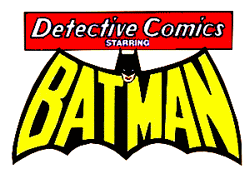
|
|
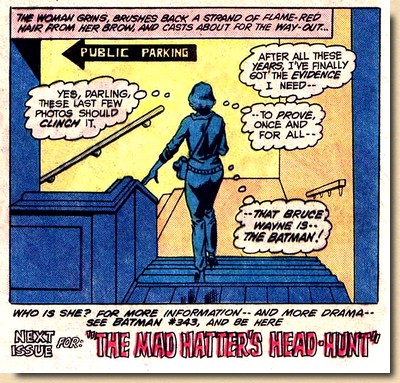 |
|
|
| |
| |
| |
REVIEW & ANALYSIS
A grippingly
good Batman story combines a coherent plot and well paced
storytelling with an interesting and complex villain. Detective
Comics #509 has to make do without the latter but
the resulting stand-alone and done-in-one story still
comes across as a good example of why the Batman comic
books of the early 1980s were - and still are - highly
enjoyable Batman fare.
|
| |
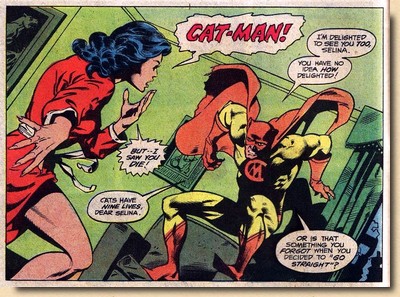 |
|
Cat-Man first crossed
Batman's path in Detective
Comics #311
(January 1963), which fell squarely into
one of the most laughable periods of the
Darknight Detective. Having
been put into storage after appearing in
three issues of Detective Comics in
1963/64, Cat-Man enjoyed something of a
comeback in the early 1980s when writer
Gerry Conway was looking at the
repertoire of Batman's Golden and Silver
Age villains which had become more or
less forgotten in most cases.
Naturally, Conway's
Cat-Man is no longer the 1960s oddball
gimmicky villain who rides a giant
mechanic cat. His only goal and purpose
is to kill; Batman first, and then Selina
Kyle. That unchecked hatred is all
because of his disfigured face which, in
turn, is all because a small piece of
fabric was torn from his "magic"
cape.
|
|
|
| |
| It is this
piece of clothing which is the only major problems this
issue has. First of all, it requires the presence of some
undefined supernatural element of "magic"
(always a weak way to explain things) for the story to
remain plausible. It is not how things generally work in
Batman's world, but strangely enough it is Cat-man
himself who makes it extremely hard to accept that plot
device as his approach to achieving his goal of murdering
Batman is so erratic that his actions seem even less
plausible than anything to do with magic. |
| |
| If he is so driven by
his hatred, why should Cat-Man bother to
tie up his victim and not stay on to make
sure his plan actually works, rather than
e.g. simply stabbing him in the
old-fashioned no-fuss way? Of course, it
is the comic book villain's way of doing
things to the hero, but the personality
and actions of Cat-Man come across as
being very incoherent by any standards -
and hence ultimately even cheesy. As a
result the story is driven by a villain
who never kicks into second gear. So why
does Detective Comics #509 work
anyway?
As comic books are a
visual form of storytelling, the highly
attractive and slick artwork by Don
Newton is definitely part of the saving
grace. This is the Bronze Age Batman at
his best, with dynamic layers of clear
lines and classic poses and a flow and
movement to each and every page. Newton
truly excels at drawing the Darknight
Detective, and as he is given ample
opportunity to do so, Detective
Comics #509 thus becomes a joy to
behold.
Batman villains are
always a matter of taste, but Gerry
Conway has enough plot cards to play that
there's still plenty a-happenin' even for
those who can't quite get into the main
story's driving character. There's a
constant stream of subplots to create
interest and atmosphere, with plot devices
and props galore.
|
|
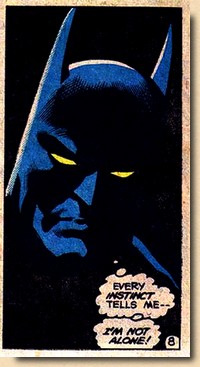 |
|
|
| |
| One very nice touch which
Conway perfected to the highest during his 1980s run on Detective
Comics and Batman was the "visual
flashback", which generally either referred to past
events in a previous issue or gave some background
information on a villain (usually his origin) or a
situation (usually explaining the root cause). It was a
great alternative to just having the characters narrate
that content or setting it down in an exposition textbox,
often adorned with a simple editorial statement of
"see issue so-and-so". Don Newton had an absolute knack for
the composition of these visual flashbacks, and Detective Comics
#509 gave readers not one but two such examples (covering
the "haunting" in Wayne Manor from Batman
#341-342 as well as Cat-Man's fall into the geyser in Batman
#342). If you had missed the content in question, Newton
provided you with some extra visual impression of what
was being relayed - a real treat.
|
| |
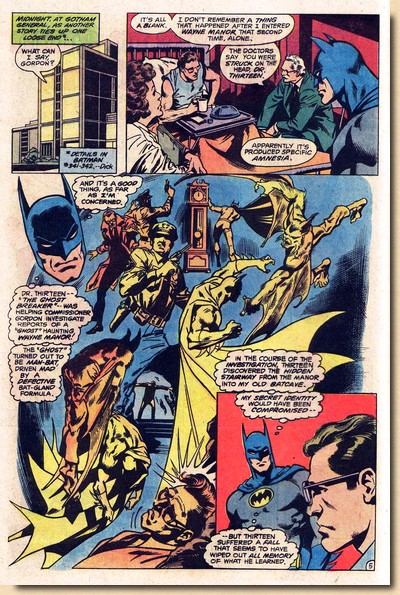 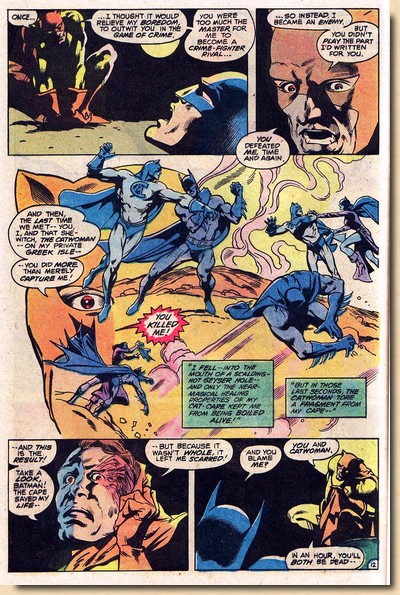
|
| |
| The
cliffhanger at the end of Detective Comics #509
- the mysterious woman secretly taking pictures of Bruce
Wayne and obviously just one step away from revealing his
secret alter ego - ends with a pointer not to
the next issue of Detective Comics but rather to
Batman #343. It is the first glimpse of what
would become a regular feature as of Detective Comics
#510: plot and storyline cross-overs between Detective
Comics (usually on sale on the second Wednesday of a
month) and Batman (usually on sale on the fourth
Wednesday of a month). |
| |
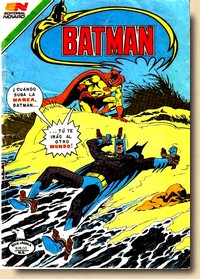 |
|
FACTS
& TRIVIA
Detective
Comics #509 went
on sale 24 September 1981 and was
published in 1982 by German publisher
Egmont Ehapa as "Neun Leben hat die
Katze" in Batman Taschenbuch #16
and as "Nine Lives has the Cat..."
in Batman #6 in 1983 by Federal
for the Australian market. Editorial
Navaro of Mexico not only reprinted the
story but also used the cover for their Batman
#1209.
The Batman feature
has so far not been reprinted.
Conway and Newton's
visual flashbacks also somewhat softened
the fact that Dick Giordano got his
references wrong (pointed out also by a
reader in the letters page of Detective
Comics #514) by refering readers to Detective
Comics #325 instead of Batman
#342 for the last encounter between
Batman and Cat-Man.
|
|
|
| |

|
| |
BATMAN and all
related elements are the property of DC
Comics, Inc. TM and © DC Comics, Inc., a
subsidiary of Time Warner Inc.
The illustrations presented here are
copyright material. Their reproduction
for the review and research purposes of
this website is considered fair use
as set out by the Copyright Act of 1976,
17 U.S.C. par. 107.

(c) 2011-2017
|
|
|
|

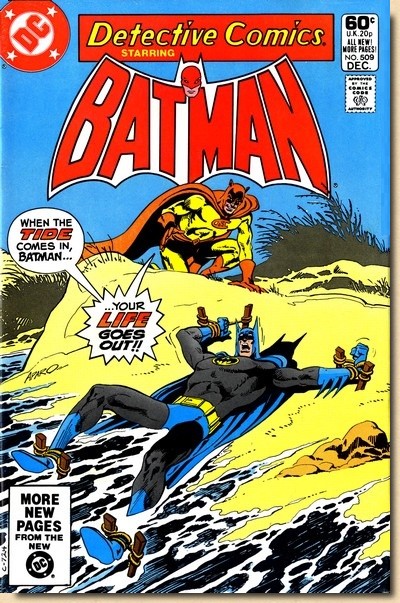
 SPOTLIGHT
ON ...
SPOTLIGHT
ON ...










